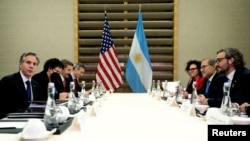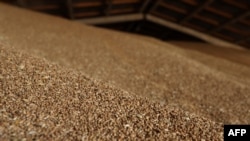The United States is sending more aid to Ukraine aimed at helping Ukrainian forces target, disrupt and destroy Russia’s ability to wage war in the Donbas region and beyond.
U.S. officials Friday unveiled a new $400 million package for Ukraine, including four more High Mobility Artillery Rocket Systems (HIMARS) and 1,000 rounds of 155 millimeter “precision capable” artillery ammunition, a type that had not been provided to Kyiv until now.
“These [weapons systems] are precise,” a senior U.S. defense official said, briefing reporters on the condition of anonymity under ground rules set by the Pentagon. “We expect them to be used by the Ukrainians to great effect given their success so far.”
That success, the official said, has played out with the ability of Ukrainian forces to slow and, at times, disrupt Russian attempts to advance by hitting Russian command and control centers and logistics hubs.
But the U.S. hopes the latest package, part of what is being described as a “steady drumbeat” of support, does more.
“A big element of what we are looking at now is that lift, which is vital for the Ukrainians to be able to continue the fight, and most importantly, I would say, for the Russians to know that the Ukrainians are going to be able to continue the fight,” the official said.
The announcement of additional U.S. aid came just days after Russian forces declared victory in Ukraine’s Luhansk province, with Ukrainian forces having retreated from their last stronghold in the city of Lysychansk.
Targeting Siversk
Western intelligence assessments believe Russian forces are now positioning themselves for a push into the Donetsk region.
Russia is “likely concentrating equipment on the front line in the direction of Siversk, approximately 8 km west of the current Russian front lines,” Britain’s defense intelligence arm said Friday.
“There is a realistic possibility that Russia’s immediate tactical objective will be Siversk, as its forces attempt to advance towards its most likely operational goal of the Sloviansk-Kramatorsk urban area,” it said.
But U.S. officials continued to describe Russian gains as incremental and “highly costly.”
“They’re [Russian forces] way behind on their timelines They’re far behind on their objectives,” the senior U.S. defense official told reporters. “The Ukrainians are, in localized places, launching effective counteroffensive.
“We don’t see this at all as Russia winning this battle,” the official added. “But the fighting is hard.”
In addition to the four new HIMARS and the precision 155 millimeter artillery rounds, the new U.S security package also includes more ammunition for the eight HIMARS already in Ukraine, tactical vehicles, demolition munitions, counter-battery systems and spare parts to help Ukrainian forces maintain systems that are getting heavy use.
Earlier Friday, the war in Ukraine and its impact on energy and food supplies dominated G-20 talks in Bali.
Host country Indonesia called on ministers to “find a way forward” in discussing the war and its impact on rising food and energy prices.
“It is our responsibility to end the war sooner rather than later and settle our differences at the negotiating table, not at the battlefield,” Indonesian Foreign Minister Retno Marsudi said at the opening of the meeting, invoking the U.N. charter to urge multilateralism and trust.
The foreign ministers of the Group of 20 industrial and emerging-market nations shared concerns about getting grain shipments out of Ukraine and avoiding devastating food shortages in Africa, the Middle East and elsewhere. But talks were marked by sharp tension: U.S. Secretary of State Antony Blinken and Russian Foreign Minister Sergey Lavrov sat at the same table, though they did not speak directly.
Lavrov accused Western ministers of straying “almost immediately, as soon as they took the floor, to the frenzied criticism of the Russian Federation in connection with the situation in Ukraine.”
“You know, it was not us who abandoned all contacts,” Lavrov told reporters after the first session. “It was the United States … and we are not running after anybody suggesting meetings. If they don’t want to talk, it’s their choice.”
Lavrov walked out of the meetings twice Friday — first, as German Foreign Minister Annalena Baerbock addressed a session on strengthening multilateralism, and second, just before Ukraine’s foreign minister, Dmytro Kuleba, addressed the session on food and energy security via video link.
At a plenary session, Blinken urged Moscow to release Ukrainian grain to the world, according to a Western official.
“He addressed Russia directly, saying, ‘To our Russian colleagues: Ukraine is not your country. Its grain is not your grain. Why are you blocking the ports? You should let the grain out,’ ” the official said.
Lavrov was not in the room when Blinken spoke.
Looming famine
The meetings follow the release of the latest World Food Program (WFP) report Wednesday. It showed a decline in global efforts to eliminate hunger and malnutrition.
Up to 828 million people, or nearly 10% of the world’s population, were affected by hunger last year, 46 million more than in 2020 and 150 million more than in 2019, agencies, including the WFP, Food and Agriculture Organization and World Health Organization, said in the 2022 edition of the U.N. food security and nutrition report.
“There is a real danger these numbers will climb even higher in the months ahead,” said WFP Executive Director David Beasley, adding that climbing prices of food, fuel and fertilizer stemming from the Russia-Ukraine war threaten to push countries into famine.
Ukraine’s agriculture ministry said Friday that in most regions of the country, farmers have begun the early harvest of wheat and legumes, gathering more than a million tons of grain so far, The Kyiv Independent media outlet reported.
Earlier this week, Ukrainian President Volodymyr Zelenskyy said he expected up to 60 million tons of grain to be harvested by fall, and that if blockades were not lifted, Ukraine would be in “a really difficult” situation.



